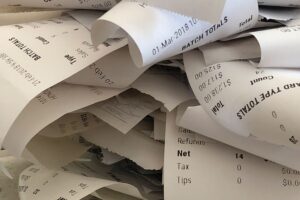Paper Recycling - Busting Some Common Myths! (Part 1)
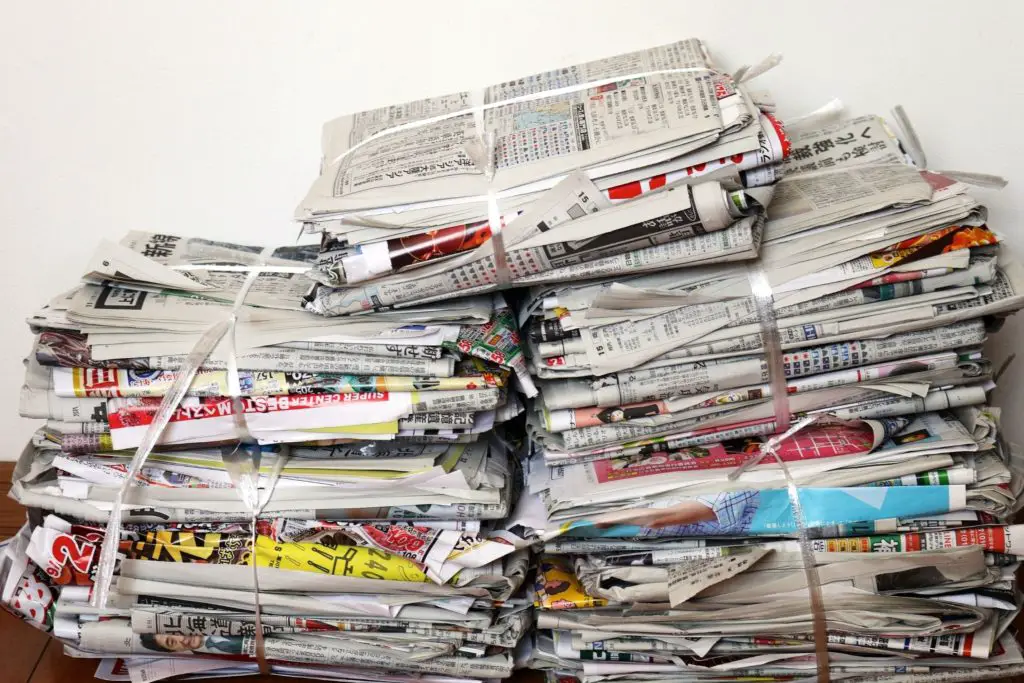
This post was last updated in 2023
Paper recycling can be such a mystery at times. There are so many things at play – How do you deal with mixed materials? Does contamination matter? Can the sorting process deal with the paper you want to recycle?
There is a wealth of information out there and in this blog post, I have pulled together relevant information to answer specific questions about paper recycling.
Here are the specific questions that are answered in this blog post:
In summary paper can be recycled even if it has contaminants like staples, plastic windows and sticky tape, provided the level of contaminants not is excessive. Other problematic items include certain types of wrapping paper, tissues and receipts. Shredded paper can be recycled when done right.
In answering these questions I’ll delve into the sorting and paper recycling process, explaining how contaminants are dealt with in both processes.
I’ll also cover not only whether an item is recyclable, but how to prep items to ensure they don’t slip through the process, addressing common concerns people have about contamination and busting some myths that exist in this space.
I did want to put everything into one blog post but it was getting out of hand!
So Part 2 will cover other common questions. It will look into pizza boxes, coffee cups, milk cartons and tetra paks, frozen food boxes, paper bags and egg cartons. You can find that linked here.
So let’s get into Part 1.
Can you recycle cardboard?
Plus a 101 on the Materials Recovery Process
Yes, cardboard is highly recyclable. Whether it’s cardboard boxes or packaging, these materials can be collected and processed at recycling facilities. However, it’s essential to ensure that the cardboard is dry to maintain its recyclability and free from most contaminants.
Yes, it needs to be dry before you throw them in your household recycling bin.
If not, there is a risk that it will be torn up to the point that it can not be sorted properly when it goes to a Materials Recovery Facility (MRF).
The MRF is where all our household recycling goes for sorting. The following is a diagram of the MRF process:
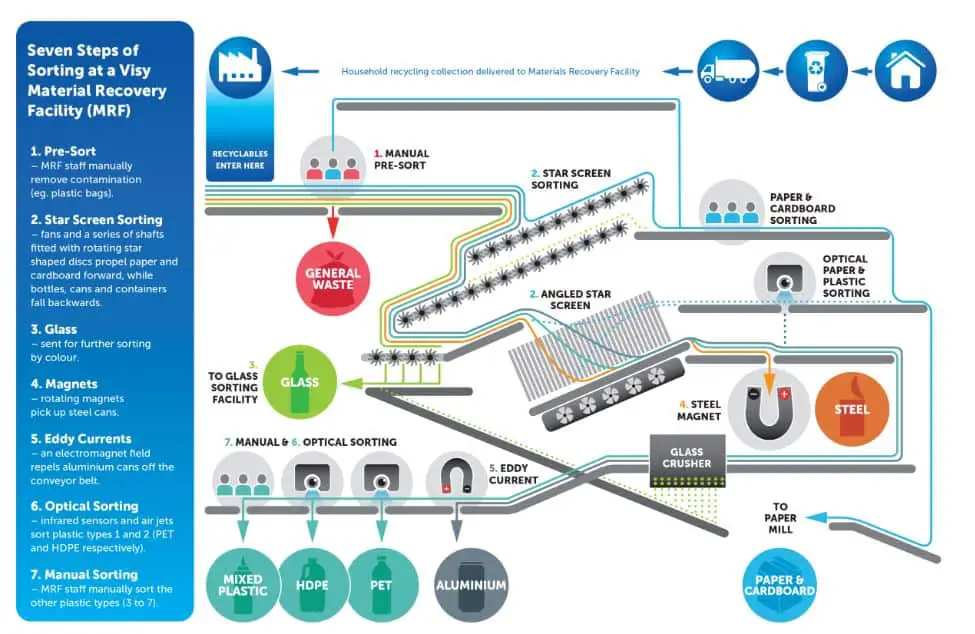
Source: https://www.visy.com.au/recycling-education/what-can-you-recycle
The screening process which extracts most of the paper, relies on the weight and density of the different items to efficiently sort through the mixed materials.
As mentioned, if cardboard is wet it may get so torn up that it won’t get screened through properly.
But there is also a risk that it will remain wet when it reaches the sorting facility. This will cause problems in the initial sorting process since the paper will be heavier than it should be.
When it comes to contaminants on cardboard packaging, refer to the section below on staples and sticky tape for guidance on this.
One type of cardboard that you will want to keep out of recycling is waxed cardboard / “coated cardboard”.
Coated cardboard can not be recycled because it is lined with plastic or wax which is bonded to the paper and can’t be removed (sources for this information can be found in my next blog post).
Lastly, a common concern when it comes to cardboard recycling is what to do if you have large amounts on hand that can not fit into your household recycling bin.
If you have large amounts of cardboard that need to be recycled, you can take them directly to a recycling centre.
To find one near you, go to the Planet Ark Recycling Near You Website linked here and enter your postcode. You will then get a list of recycling centres near you.
Not all will take domestic quantities of cardboard for recycling. So you will need to ring around to find one that will accept what you have.
Do you need to remove stables or sticky tape before recycling paper?
Plus a 101 on the Paper Recycling Process
If your paper or cardboard has staples, sticky tape or other contaminants like this, it isn’t always necessary to remove them before putting paper into the recycling bin. Staples and tape can be separated during the recycling process. However, this is dependent on several factors.
It depends on where your council sends the recycling it collects and how much of the paper or cardboard is contaminated.
For those of us in Australia, it is difficult to say where your paper recycling ends up – it may be processed onshore or it may be sent overseas for recycling.
There are only five companies that operate paper recycling plants and they are located in NSW, VIC and QLD.
It is likely that if you live in a metropolitan area in one of these states, your paper waste is sent to one of these companies for recycling.
Visy is one such company and they are the largest paper recycling company out there.
Their recycling process can handle contaminants. And I would venture to say that all paper recycling plants in Australia can deal with most contaminants, as they are likely following the process shown below:
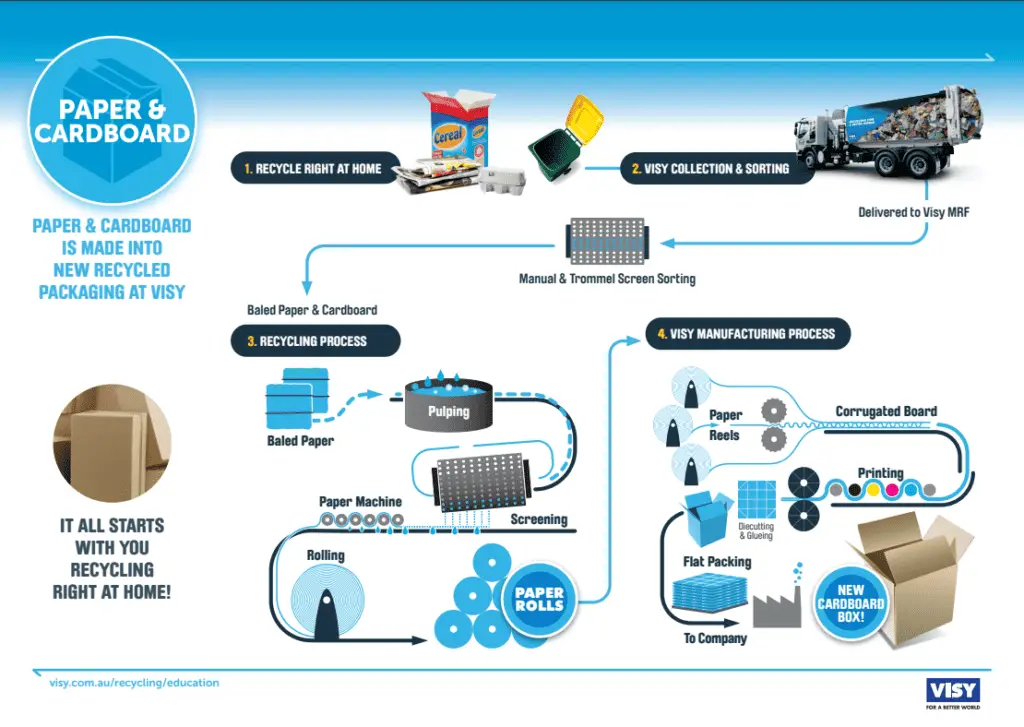
Source: https://static1.squarespace.com/static/534fe620e4b0337f7ff5c5da/t/611c45aafafbe56db3bdac52/1629242797188/Visy+Paper+Cardboard+Sort+Manufacture+A4.pdf
It’s not mentioned on the diagram but some searching around revealed that contaminants are removed during the initial screening process.
The best video I could find that demonstrates this is shown below.
The best video I could find that demonstrates this is shown below.
It’s a long video but I wanted to link it because it helps to shed light on so many things. The video starts at timestamp 12:30 because that’s when they start discussing the screening process:
Essentially different stages in the screening process can deal with different types of impurities, ensuring paper fibres are all that remain in the end.
The finer materials and adhesives are the last thing to be screened and it’s pretty cool to see how these come out in the end.
If you are keen to learn more, there is another video on the same channel that covers this process (Paper Recycling: Market Deinked Pulp).
While these videos are tours of paper mills in the US, the process described is not too different to the one outlined by Visy.
But of course, things are not so simple in Australia, as I alluded to before.
For those of us along the eastern seaboard, our recycling is likely to go to one of these recycling plants. Contaminants like stapes and sticky tape are not an issue for these plants – they will be screened out.
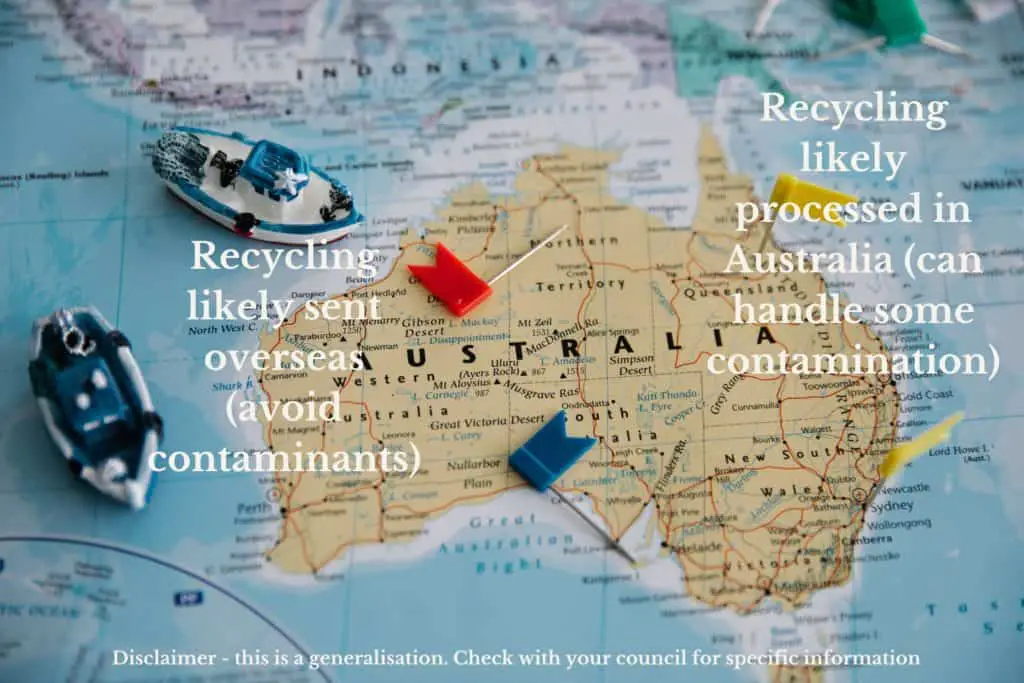
But for those of us in areas where paper waste is sold overseas, it’s a different story.
Contaminants can become a real issue if they are found in large quantities in paper bales sold overseas. Overseas markets will reject or pay substantially less for paper bales that have contaminated material. And there is a risk that contaminated bales will end up in landfill.
In these situations, you need to be careful with what you put into the recycling bin. If your paper or cardboard is covered in stables or tape, keep it out!
How do you know if your waste is going overseas? There’s no easy way to know this. You will need to contact your council for information specific to your area.
Generalising based on what I have noted above, I would say those along the eastern seaboard can throw contaminated paper in the recycling bin since the process can deal with these. While those in Western Australia, South Australia, Northern Territory, Tasmania and possibly Canberra, need to keep contaminated paper out of the recycling bin.
Even for those along the eastern seaboard, if there is an excess of sticky tape, do your best to remove it as much as possible before putting it in the recycling bin. This is because removing impurities does come at a cost to paper recyclers.
If you can’t remove the excess and your paper or cardboard is just covered in the stuff, probably best to place the item in the landfill bin.
Can you recycle glossy paper?
Yes, generally glossy paper can be recycled. However, it’s worth noting sometimes glossy paper is coated with a thin layer of plastic, which can affect the recycling process. Conduct one of the tests noted below to determine if the glossy paper you have can go in the recycling bin.
According to a couple of websites, glossy paper is typically created using natural additives such as minerals, resins or clays. Recycling companies can wash off these natural substances and they don’t pose a threat to the recycling process.
However, some glossy papers get their gloss from plastics, not natural substances. This is a problem for the paper recycling process because, to be recycled, the paper needs to break down in water. If it is covered in plastic, that will prevent it from breaking down.
When a piece of paper has been laminated, that’s easy enough to tell and the item will need to go into landfill.
But what if you have a piece of paper that looks glossy and you don’t know if it’s because of natural minerals or plastic? Can you recycle it or not?
The best way to tell is to conduct one or more of the three tests to check whether it can be recycled. Check out this reel on my Instagram account which demonstrates these tests:
In summary, you need to conduct a:
- Rip test – if it rips easily, it is not covered in plastic and can be recycled
- Scrunch test – if it scrunches up easily and retains its shape, then it is not covered in plastic and can be recycled or
- Soak test – soak the paper in water for several hours. If it breaks up easily in water, then it is not covered in plastic and can be recycled
The rip test is usually all you need to do.
I could not find any other evidence to back this claim and it is not supported by the recycling information provided by my local council in the Sydney metro area. I would not be concerned with aspect.
Indeed, glossy paper is rarely free of toxic chemicals – this is why many warn against putting glossy or even plain white paper into your compost bin.
But recycling plants have been accepting coloured paper for a long time and I can’t see this posing any real threat to the recycling process.
Can you recycle wrapping paper?
The recyclability of wrapping paper depends on its composition. Plain wrapping paper is usually recyclable, but versions with metallic finishes, glitter, or plastic coatings may not be recyclable. These should be reused wherever possible. If not, they will need to go into landfill.
Kraft paper is very much recyclable – that’s the plain typically brown rolls of wrapping paper that people sometimes use.
Anything with a glossy-coloured surface will need to be tested using the three tests mentioned above to ensure there isn’t a plastic coating. The same goes for metallic wrapping paper.
I have found the scrunch test works best for testing wrapping paper. Scrunch it and you will see it either try and open itself up (not recyclable) or stay mostly scrunched up (recyclable).
When it comes to wrapping paper with glitter, the general advice is this type of paper can not be recycled.
While recycling plants can deal with impurities of all shapes and sizes (see the section above for more details), glitter is particularly difficult to screen out. So wrapping paper covered with glitter can not go in the recycling bin.
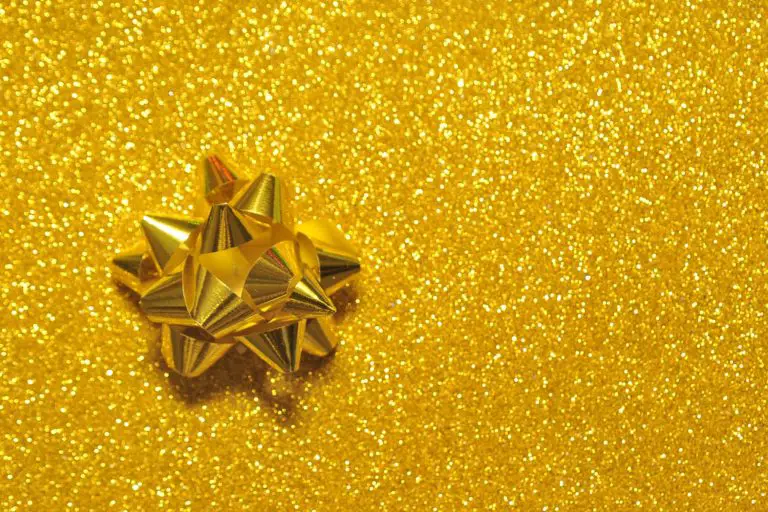
You also need to consider the thinness of the paper – if it is too thin, the paper can’t be recycled because it does not have the fibres that would allow it to be recycled easily (see below for more information).
So tissue paper will need to go into landfill. Or a compost bin if you have one.
In general, it should be safe to put wrapping paper into your household recycling bin. Just not anything too thin, anything covered with glitter or anything that does not pass the scrunch test.
Can shredded paper be recycled?
Yes, shredded paper can be recycled, but it’s crucial to contain it properly. Otherwise shredded paper will become mixed with other materials during the sorting process, polluting other recycling streams. To prevent this, place shredded paper in a paper bag or box before putting it in the recycling bin.
This was a tricky one to answer because a lot of the advice online varies widely. And a lot of the advice is from the UK or US.
Two issues are brought up when it comes to recycling shredded paper:
- It can be difficult to separate it from other items when it goes into a co-mingled recycling bin. They either end up polluting other recycling streams or are screened through as impurities and eventually burned or placed in landfill. It can also get caught in sorting machinery, which can cause problems.
- In some paper recycling processes, the recycler needs long strands of paper to catch and stick to the screens that are used to remake paper. Small pieces like shredded paper tend to pass through the screens, creating a lumpy mess.
Point 2 seems to be an issue overseas. The blog post that mentioned this issue is based in the UK. Looking into it a bit more, I can see that the recycling process this blog post is referring to is different to the process used in Australia.
So if you are outside of Australia, you would need to check with your council to see if shredded paper can be recycled or not.
As for the first issue, this is easily addressed by containing the shredded paper in a paper box or bag before putting it in the recycling bin.
A cursory check of several locations around Australia reveals that this is the advice all around – never put shredded paper loosely in the recycling bin and make sure it is contained so it doesn’t prove to be a nightmare for the sorting process.
Alternatively, if your council offers FOGO (food organics and garden organics) bins, your shredded paper can go in these bins. No need to contain it – just place them loosely in the bin.
This will help absorb moisture, reduce smells and can act as a great source of carbon for when it’s made into compost.
Of course, if you have a compost bin in your home or you take food waste to a share waste host, you know what to do with that shredded paper! Next to autumn leaves, shredded paper is absolute gold.
Are tissues recyclable?
No, tissues are generally not recyclable. Tissues are made from shorter paper fibres that are difficult to recycle efficiently. Used tissues are also considered contaminated waste due to their contact with germs and bodily fluids. It’s best to dispose of them in the regular trash.
The same goes for napkins and paper towels. And tissue paper that is used as wrapping paper.
So you would think the reason for this is because tissues are too thin for the recycling process to deal with. Weirdly enough, that isn’t the issue.
When tissues and other products like these are made, chemicals are added to paper fibres to strengthen bonds that are normally broken down when paper is added to water. So tissues are made to be stronger than normal paper.
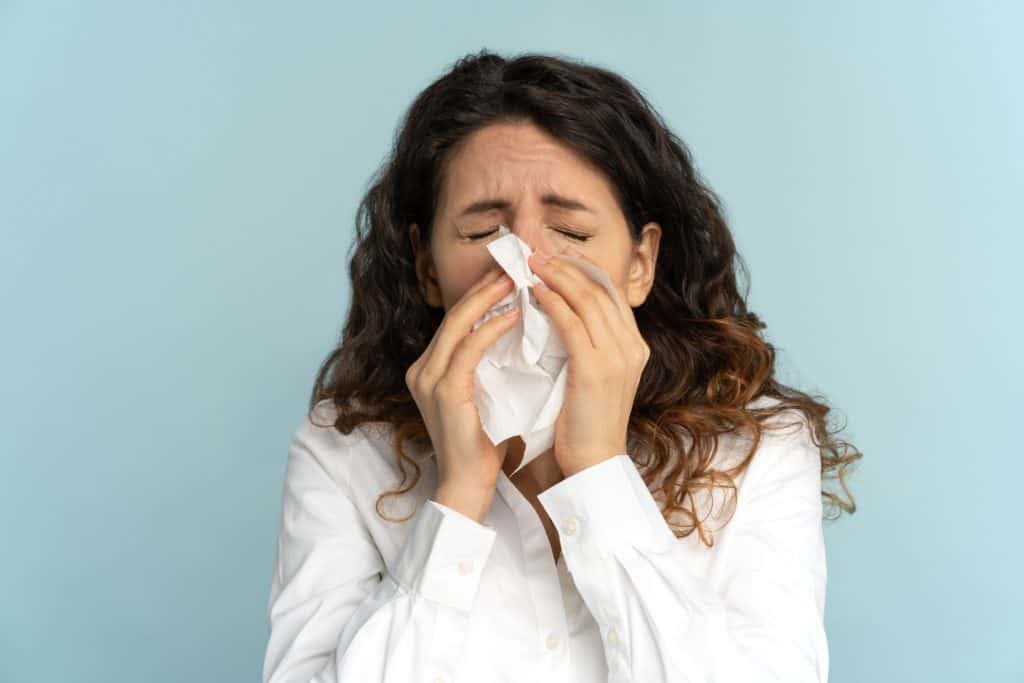
Unfortunately, a key step in the paper recycling process is to turn paper into a pulp. If the product refuses to turn into a fine enough pulp, it can’t be recycled and will be spat out as a containment.
There is also the fact that these items are typically covered in grease or other icky things. While the recycling process can deal with these contaminants, this is an occupational health and safety issue for people manually sorting through items in a MSF, since the beginning of the MSF process involves sorting items by hand (see above).
So afraid these go into landfill.
Unless of course, you have a compost or food organics bin, in which case you can place it there.
Are receipts recyclable?
Thermal paper receipts, commonly used in cash registers, are not accepted for recycling. This is because they often contain Bisphenol A (BPA) or Bisphenol S (BPS), chemicals that can be harmful to the recycling process. It’s recommended to throw thermal paper receipts into landfill.
While the paper could be recycled, these chemicals can not flow into the recycling process because the resulting product would be contaminated with BPA and BPS.
This matters because recycled paper could be turned into toilet paper, napkins and other everyday items that come in contact with the skin.
BPA and BPS can not be removed through the recycling process. For that reason, it just can’t enter the process to begin with. Also “…the recycling of thermal paper can lead to the release of BPA into the environment through sludge and wastewater“.
We wouldn’t want that.
Some receipts can be recycled because they haven’t been treated with BPA.
So how do you know if you have thermal BPA/BPS receipts on your hand?
Follow this advice from the Plastic Pollution Coalition:
Scratch the printed side of the paper. If you see a dark mark, the paper is thermal... While some manufacturers make “BPA-free” thermal paper, they often use a similar chemical (BPS), which also may pose health hazards similar to BPA. Both are easily transferred to the skin.
If the paper leaves a dark mark when scratched, it’s a sign that the paper relies on BPA or BPS for printing. Keep this out of the recycling bin.
If there is no dark mark, it can be recycled.
To be honest, I don’t bother with this. I try to avoid taking receipts and if I do have receipts on hand, I don’t spend time scratching them – I just place them all into the landfill bin.
I draw the line at scratching receipts – in the bin they all go! Yes, not doing the most eco-friendly thing here but if you know my approach to things, this would not come as a surprise.
On a side note, about keeping safe – I had no idea that receipts were such a potential threat to our health. Read more about it here: https://www.sciencenewsforstudents.org/article/explainer-store-receipts-and-bpa
And given we don’t live in a bubble, here are some tips to minimise the risk of exposure: https://pandapaperroll.com/7-tips-use-thermal-receipt-paper-healthily/
Are envelopes recyclable?
Yes, envelopes made of paper can generally be recycled. It’s not necessary to remove plastic windows from envelopes, as they are typically separated during the recycling process. However, envelopes with bubble wrap lining or other non-paper components are not suitable for recycling.
As noted above, the paper recycling process can deal with impurities as they are removed in the screening stage. So plastic windows and labels, even small plastic windows on envelopes, pose no problems for the paper recycling process.
And even your paper recycling stream is send overseas, these contaminants would be hardly visible in a large bale of paper, so they are unlikely to cause any problems.
However, ultimately any plastic impurities will end up in landfill after it goes through the initial screening process process. That being the case, and keeping in mind dealing with impurities is an additional cost for recyclers, it would be good to remove the plastic if you can.
When it comes to padded envelopes. It is highly unlikely that these items can be recycled because the bubble wrap lining in these envelopes is so closely bonded to the paper.
Since these items are likely to be screened out and sent to landfill, there is no point in placing them in the recycling bin – you should place them in the landfill bin yourself, saving the energy and resources needed to screen them out.
Recycling paper products is a simple yet effective way to contribute to a more sustainable environment. By understanding where our recycling goes for processing, the steps involved in the recycling process and how contaminants are handled, you can be better informed on how to deal with those tricker items.
It’s small things but through these conscious actions we can collectively work towards a more sustainable future .
.
 .
.xxx Tahsin


